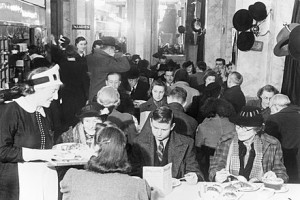Found in Old Inns of Suffolk, an often consulted work by local historian  Leonard P Thompson, is a complaint about the ‘catchpenny ‘afternoon teas served up by typical road houses and other mediocre eating places.
Leonard P Thompson, is a complaint about the ‘catchpenny ‘afternoon teas served up by typical road houses and other mediocre eating places.
Writing in 1948,Thompson argues that excellent and value for money teas can still be found in Britain, but that the ones offered by hotels and similar outfits are invariably unimaginative, mean and ridiculously expensive.
Thompson begins his complaint with a eulogy to a tea he once had at The Fleece, Boxford, near Sudbury, once the home village of the late Peter Haining, the doyen of paste and scissors anthologists, from whose archive ( now owned by Jot 101) Old Inns of Suffolk may have come.
‘It was a Tea of an essentially home-made order. There was plenty of bread-and-butter. There was potted meat and home-made jam. There were biscuits, there was cake. And there was a pot of refreshing, honest to-goodness tea. The price was extraordinarily reasonable. And it all pointed to this moral: if one country inn can observe the ancient traditions of its proud place in England’s social history, so can others. Some, indeed, do, but they are all too few; and of that few, the majority are completely unimaginative. Hotel Teas display the least imagination; two or three wafers of rather dry bread, lightly smeared with a mixture of margarine and butter; perhaps a couple of diminutive sandwiches of indefinable and often dubious content; a piece of dry cake, or an equally dry and hideously plain bun. Such is the usual composition of the average Hotel Tea .
Less honest than these Teas, argues Thompson, are those offered by the ‘rather arty-crafty and frightfully genteel type of Road House’ that he had recently visited:
‘ A terribly refined young woman told us that we could have a “ sendwich tea “ or a “ hem and seled tea “ . There was not, you will observe, any opportunity given to express one’s individuality; you were not allowed to ask for bread-and-butter and jam or toast; just “ sendwiches” ; “ hem and seled”. And so, because we rarely see it these days, we ordered ham for the good of ourselves, and salad for the good of the house; and there was precious little of either! The bill was phenomenal; we have paid less for a really excellent lunch in more than one first-class Suffolk hotel. We might add that a friend once entered this same den of thieves and ordered this same catch-penny dish, but by the time they got round to serving him there was no more ham. Never mind, he would just have the salad. There was no reduction in the bill!
Plus ca change. Though there may not be an exact equivalent of the 1948 Road House today, the response of the average Briton to such poor service doesn’t seem to have changed over the past seven decades.
‘People who are fleeced in restaurants rarely complain, for the average Briton hates the very thought of a “scene”. And the thieves, being good psychologists, trade on this. ‘
As indeed they still do. Incidentally, it would be interesting to know if those travellers in the eighteenth century, who recorded in their diaries the poor quality of their inn food and beds, actually complained to the inn- keeper.
One striking feature of this commentary is the way Thompson manages to drive home his point about the pretensions of some eating establishments by satirising the mangling of the English language that was once so often accepted as received pronunciation by, for instance, the BBC.
Jot fans might like to know that England Eats Out by the brilliant social historian John Burnett, is an excellent commentary on this area of food history. [R.M.Healey]
